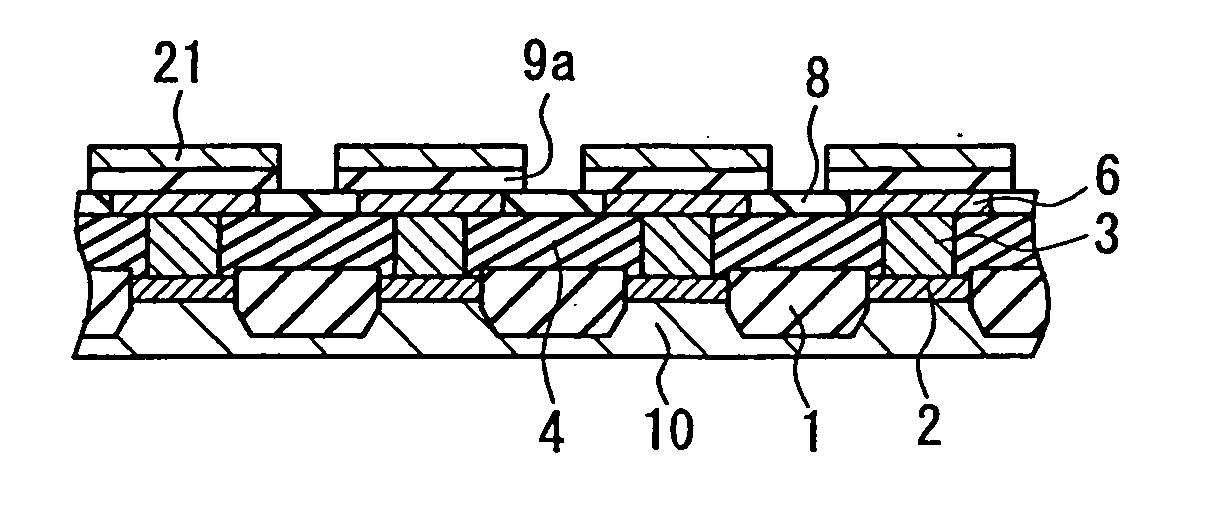Semiconductor device and method for manufacturing the same
a semiconductor and device technology, applied in semiconductor devices, capacitors, electrical devices, etc., can solve the problems of large non-uniformity in polishing speed, scratches, etc., to achieve the effect of reducing global step difference, accelerating step leveling, and suppressing peeling of lower electrodes and scratches
- Summary
- Abstract
- Description
- Claims
- Application Information
AI Technical Summary
Benefits of technology
Problems solved by technology
Method used
Image
Examples
embodiment 1
[0052] A method for manufacturing a ferroelectric memory in accordance with Embodiment 1 of the present invention is described with reference to FIGS. 1A to 1J. These drawings show a section of a memory cell array portion during the steps of manufacturing a ferroelectric memory.
[0053] First, as shown in FIG. 1A, isolation regions 1 are formed on a semiconductor substrate 10, and a high-concentration impurity diffusion layer 2 is formed between the isolation regions 1. Then, an interlayer insulation film 4 made of SiO2 is formed on the isolation regions 1 and the impurity diffusion layer 2, and contact plugs 3 (made of tungsten) that are electrically connected to the impurity diffusion layers 2 are formed in the interlayer insulation film 4. A layered film (of 300 nm thickness) including a titanium nitride barrier layer (150 nm thick) and a platinum film (150 nm thick) serving as a first conductive film 5 is formed on the interlayer insulation film 4 and the contact plugs 3.
[0054] ...
embodiment 2
[0067] The following is a description of a method for manufacturing a ferroelectric memory according to Embodiment 2 of the present invention, with reference to FIGS. 2A to 2F. FIGS. 2A to 2F shows a section of a memory cell array portion during the steps of manufacturing a ferroelectric memory. This embodiment is an example of a modification of the manufacturing method according to Embodiment 1. The steps in FIGS. 2A to 2D are similar to those in FIGS. 1A to 1D, so that their further explanation has been omitted.
[0068] As shown in FIG. 2E, the insulating film 8 at the aperture portions of the resist pattern 11 is partially removed by dry etching to form the recesses 12. It is preferable that the depth of the recesses 12 is as deep as possible. By forming the recesses 12, the polishing amount of the insulating film 8 in the following polishing step can be reduced, accelerating the step leveling.
[0069] Then, as shown in FIG. 2F, the insulating film 8 is polished by CMP to planarize...
embodiment 3
[0072] Referring to FIGS. 3Aa to 3Af, the following is a description of a method for manufacturing a ferroelectric memory according to Embodiment 3 of the present invention. FIGS. 3Aa to 3Af show sectional views of a memory cell array portion during the steps of manufacturing a ferroelectric memory. FIGS. 3Ba to 3Bf show sectional views of a metal wiring portion. The steps of FIGS. 3Aa to 3Af correspond to the steps of 3Ba to 3Bf, and are performed at the same time.
[0073] First, in a memory cell array portion, isolation regions 1 are formed on a semiconductor substrate 10, and a high-concentration impurity diffusion layer 2 is formed between the isolation regions 1, as shown in FIG. 3Aa. Then, an interlayer insulation film 4 made of SiO2 is formed on the isolation regions 1 and the impurity diffusion layer 2, and contact plugs 3 (made of tungsten) that are electrically connected to the impurity diffusion layers 2 are formed in the interlayer insulation film 4. A layered film (of 30...
PUM
 Login to View More
Login to View More Abstract
Description
Claims
Application Information
 Login to View More
Login to View More - R&D
- Intellectual Property
- Life Sciences
- Materials
- Tech Scout
- Unparalleled Data Quality
- Higher Quality Content
- 60% Fewer Hallucinations
Browse by: Latest US Patents, China's latest patents, Technical Efficacy Thesaurus, Application Domain, Technology Topic, Popular Technical Reports.
© 2025 PatSnap. All rights reserved.Legal|Privacy policy|Modern Slavery Act Transparency Statement|Sitemap|About US| Contact US: help@patsnap.com



